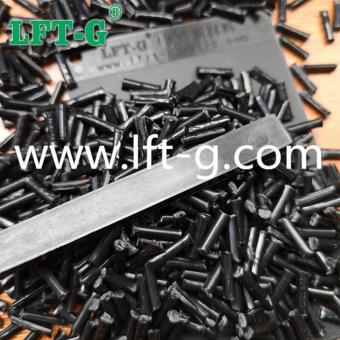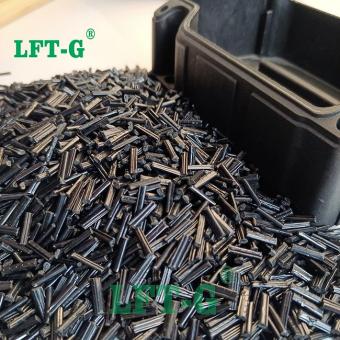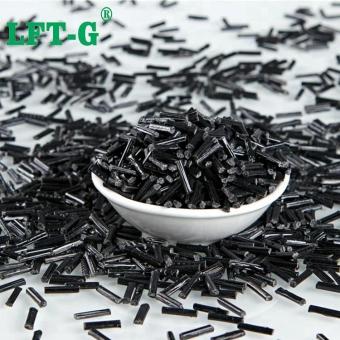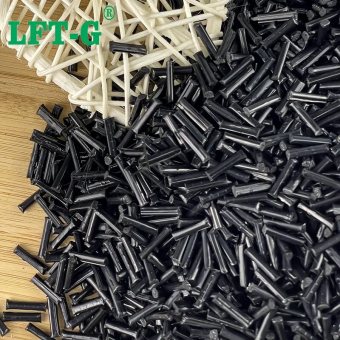langes, kohlefaserverstärktes Polyamid-Nylon pa66 repariert durch Lösungsimprägnierungsprozess. langes kohlefaserverstärktes pa66 typischer Anwendungsbereich von Automobilteilen, mechanischen Teilen, elektrischen und elektronischen Produkten, technischem Zubehör und anderen Produkten.
-
Fortgeschrittene KohlenstoffmaterialPA66 Long Carbon Faser verstärktes Material bietet außergewöhnliche Festigkeit, Steifigkeit und leichte Eigenschaften, was es ideal macht Hochleistungsanwendungen Es bietet Ausgezeichnete Wärmefestigkeit, dimensionale Stabilität und Aufprallwiderstand Weit verbreitet in Automobil-, Luft- und Raumfahrt- und IndustriekomponentenEs sorgt für Haltbarkeit und Zuverlässigkeit.
- Polyamid Nylon PA 66
- PA66 Preis pro kg
- Nylon PA66 Plastikmaterial
- CFK -Materialien
- China Hersteller Kohlefaser
- Polyamid 66 Kunststoff
Tags :
-
Xiamen LFT-G Polyamid 66 Langes Kohlenstofffaser-Fabrik-Verschleißfestigkeit für AutoteileDie Hauptvorteile von Nylon 6 sind seine Steifheit und Resistenz gegen Abrieb . Darüber hinaus weist dieses Material eine hervorragende Aufprallfestigkeit, Verschleißfestigkeit und elektrische Isoliereigenschaften auf.
- PA66 Kunststoff Rohstoffeinspritzung geformt
- PA66 recycelte reine Pellets Leichte Gewicht
- lange Kohlefaser PA66 natürliche schwarze Farbe
- PA66 LCF -Granulat Stattdessen Metallpolymere
- Elektronisches Gerät mit geringer Verachtung
- Autoteil und Luft- und Raumfahrtteile
Tags :
-
LFT Nylon Polyamid 66 lange kohlefaserverstärkte VerbindungenPA66-CF40 ist ein mit 40 % langen Kohlenstofffasern verstärktes PA 66, das außergewöhnliche Festigkeit, Kriechfestigkeit, Steifigkeit und Dimensionsstabilität bietet. Nach der Modifikation weist PA66-CF40 hervorragende mechanische Eigenschaften auf, wodurch es äußerst belastbar und ideal für Hochlastanwendungen in Umgebungen mit extremen Temperaturen ist. Dieses Material eignet sich besonders für Bauteile, die eine hohe Festigkeit und Haltbarkeit über längere Zeiträume erfordern, wie zum Beispiel Abdeckungen und Strukturteile in Maschinen und Fahrzeugen.
- PA66 PA-Füller CFK 40 30 20
- PA66-CF30 Polymaker-Anwendung
- Thermoplastisches Harz, hergestellt in China
- PA66-Filament-Polymerharz-Pellets
- EDM-Großhandel mit PA 66-Materialien auf Lager
- Bester Preis PA66 hochfest
Tags :
-
Xiamen LFT-G Polyamid 66 Long Carbon Fiber gefüllte Verschleißfestigkeit für AutoteilePhysikalische Eigenschaften von Nylonmaterialien Hervorragende mechanische Eigenschaften: hohe mechanische Festigkeit, gute Zähigkeit. Ausgezeichnete Selbstbenetzung, Verschleißfestigkeit: kleiner Reibungskoeffizient, lange Lebensdauer als Getriebekomponente. Ausgezeichnete Wärmebeständigkeit: Die Wärmeformbeständigkeitstemperatur von PA66 ist sehr hoch, kann lange Zeit bei 150 Grad Celsius verwendet werden, PA66 nach Glasfaserverstärkung, die Wärmeformbeständigkeitstemperatur beträgt 252 Grad Celsius oder mehr. Hervorragende elektrische Isolationseigenschaften: Sein Durchgangswiderstand ist sehr hoch, hohe Durchbruchspannungsfestigkeit, ist ein ausgezeichnetes elektrisches/elektronisches Isolationsmaterial. Einführung von mit Nylon66 gefüllten LCF-Pellets PA66 ist ein hochleistungsfähiger technischer Kunststoff mit Feuchtigkeitsaufnahme, schlechter Dimensionsstabilität von Produkten, Festigkeit und Härte und Metall. Um diese Mängel zu überwinden, wurden bereits in den 1970er Jahren Kohle- und Glasfasern eingesetzt, um die Leistung zu verbessern. PA66 verstärkt mit Kohlefaser-Fasermaterialien in den letzten Jahren die Entwicklung von schneller, weil PA66 und Kohlefaser hervorragende Leistung auf dem Gebiet der technischen Kunststoffe sind, das Verbundmaterial umfassende Verkörperung der Überlegenheit der beiden, wie Festigkeit und Steifigkeit als die unverstärkte PA66 ist viel höher als die der Hochtemperatur-Kriechen ist klein, die thermische Stabilität eine deutliche Verbesserung der Maßhaltigkeit der guten, verschleißfesten. Derzeit handelt es sich bei PA66-Kohlefaserverbundwerkstoffen hauptsächlich um kurzgeschnittene oder lange kohlefaserverstärkte Partikel, die in der Automobilindustrie, bei Sportartikeln, Textilmaschinen, Luft- und Raumfahrtmaterialien und anderen Bereichen weit verbreitet sind. Kohlefaser ist leicht, hat eine hohe Zugfestigkeit, Abriebfestigkeit, Korrosionsbeständigkeit, Kriechfestigkeit, elektrische Leitfähigkeit, Wärmeübertragung usw. Sie ist der Glasfaser sehr ähnlich, aber der Glasfaser überlegen. Im Vergleich zu Glasfaser ist der Modul dreimal höher, was einem Material mit hoher Steifigkeit und hoher Festigkeit entspricht. Datenblatt von PA6-LCF als Referenz Aus den Experimenten der technischen Abteilung wissen wir, dass die Biegefestigkeit, der Biegeelastizitätsmodul, die Schlagfestigkeit und die ebene Scherfestigkeit des mit Kohlenstofffasern PA66-Fasern versetzten Materials mit zunehmendem Kohlenstofffasergehalt und Querscherfestigkeit zunehmen leicht abgenommen, insgesamt ist die Festigkeit des Materials dramatisch gestiegen. Anwendung von PA66-LCF Zertifikat Qualitätsmanagementsystem ISO9001/16949-Zertifizierung Nationales Laborakkreditierungszertifikat Innovationsunternehmen für modifizierte Kunststoffe Ehrenurkunde Schwermetall-REACH- und ROHS-Prüfung Fabrik und Labor Fragen und Antworten 1. Gibt es einheitliche Referenzdaten für die Leistung von Kohlefaserprodukten? Die Leistung bestimmter Kohlefaserfilamente ist festgelegt, beispielsweise der Kohlefaserfilamente T300, T300J, T400, T700 usw. von Toray. Es gibt eine Reihe von Parametern, die verfolgt werden können. Allerdings gibt es keinen einheitlichen Standard zur Messung der Carbonfaser-Verbundprodukte. Erstens führen die unterschiedlichen Arten der ausgewählten Rohstoffe zu unterschiedlichen Leistungen der Produkte, und dann führt dies aufgrund der Wahl der Matrix und des unterschiedlichen Designs der Produkte zu unterschiedlichen Leistungen der Produkte. Zusätzlich zu einigen gängigen Kohlefaserrohren, Kohlefaserplatten und anderen konventionellen Teilen werden bei den meisten Kohlefaserprodukten bei der Herstellung vor dem Test Muster verwendet, um festzustellen, ob die Leistung des Produkts mit der Verwendung des erwarteten Standards übereinstimmt und als Basis, um die Produktion und Nutzung großer Mengen durchzuführen. 2. Sind Kohlefaserverbundprodukte teuer? Der Preis von Kohlefaserverbundprodukten hängt eng mit dem Rohstoffpreis, dem Technologiestand und der Produktmenge zusammen. Einige Produkte stellen hohe Anforderungen an die Industrieumgebung. An die Leistung von Kohlefaserprodukten und -materialien werden besondere Anforderungen gestellt, die die Auswahl spezifischer Rohstoffe erfordern. Je höher die Leistung, desto höher der natürliche Preis der teureren, wie z. B. die Rohstoffe Anwendung von orthopädischen thermoplastischen Kohlenstofffaser-PEEK-Materialien. Je komplexer der Produktionsprozess ist, desto größer sind natürlich die Arbeitszeit und der Arbeitsaufwand, und die Produktionskosten steigen. Je größer jedoch die Bestellmenge, desto geringer sind die Kosten pro Stück, sobald die Massenproduktion eines bestimmten Carbonfaserprodukts etabliert ist. Auf lange Sicht wird die überlegene Leistung von Kohlefaser die Lebensdauer des Produkts verlängern, die Anzahl der Wartungsarbeiten reduzieren und sich auch sehr positiv auf die Reduzierung der Nutzungskosten auswirken. 3. Sind Kohlefaserverbundprodukt...mehr sehen
-
LFT Polyamid 6.6 Hersteller von kohlenstofffasergefüllten Compounds, grüne MaterialienPolyamid, das auch unter dem Handelsnamen Nylon bekannt ist, weist hervorragende hitzebeständige Eigenschaften auf, insbesondere in Kombination mit Additiven und Füllstoffen.
- Thermoplastisches, harzverstärktes Nylon PA 66-Material
- Faserfüllungspolymer anstelle von Metallstahl
- Probieren Sie kostenlos neues CFK aus natürlichem Kunststoff
- Konstruktionsteile aus Kunststoff
- modifiziertes Harz, guter Preis, niedrige Mindestbestellmenge
- Autoteileanwendung guter Preis
Tags :
-
LFT Polyamid 66 Hochleistungs-LangkohlefaserverstärkungPA66-Kohlefaser-leitfähiges, mit Kunststoff verstärktes Nylon-Kunststoffmaterial, das die elektrische Leitfähigkeit von Metall (eine an beide Enden des Materials angelegte Spannung, durch das Material durch den Strom) und die verschiedenen Eigenschaften von Kunststoff (d. h , Materialmoleküle bestehen aus vielen kleinen, sich wiederholenden Struktureinheiten). Verpackung, elektromagnetische Abschirmung und andere Bereiche. Es ist eine wichtige Art von leitfähigen Polymermaterialien. Leitfähiges antistatisches Material. Halbleitendes Abschirmmaterial, das in Mittel- und Hochspannungskabeln verwendet wird. Leitfähiger Kunststoff ist eine Art funktionelles Polymermaterial, das Harz und Leitfähigkeit mischt Material und wird wie Kunststoff verarbeitet. Die Dichte des leitfähigen antistatischen Kunststoffprodukts ist gering, das Gewicht wird um 50 % reduziert; Biegemodul (MPa): 2400 ~ 6000. Mit zunehmendem Kohlenstofffasergehalt nehmen die Zugfestigkeit, die Biegefestigkeit und der Biegeelastizitätsmodul der Verbundwerkstoffe zu. Die Schlagfestigkeit des freitragenden Balkens nimmt zunächst zu und dann ab, und die Schlagfestigkeit erreicht ihren Maximalwert, wenn die Kohlenstofffasermasse vorhanden ist Der Bruchteil beträgt 30 %, also. Der Grund dafür ist, dass bei einem relativ großen Fasergehalt die Bruchspannung und ihre Energieschwelle ansteigen und Absorptionsmethoden wie die Verlängerung des Bruchweges, die durch die Vermeidung von Fasern verursacht werden, die Deformation der Faser-Matrix-Grenzfläche und das Herausziehen der Fasern hinzukommen. während die innere Kerbwirkung der Fasern langsam zunimmt und somit die Schlagzähigkeit zunimmt. Wenn der Massenanteil der Kohlenstofffasern mehr als 30 % beträgt, nimmt die innere Kerbwirkung der Kohlenstofffasern mit zunehmendem Kohlenstofffasergehalt zu und die Schlagzähigkeit nimmt ab . Für weitere technische Fragen kontaktieren Sie uns bitte: + 86 139 5009 5727 WEB:www.lft-g.com
- Lange Kohlefasern verbessern die Pellets
- Roving aus Kohlefaser PA66 statt Metall und Stahl
- Nylon66-Verbundgranulat zur Injektion
- Hochwertiger PA66-Langfaserverbundstoff.
- Polyamid-Langfaserverbundwerkstoff
- Frischer Kunststoff PA6 LCF40 für Autoteile
Tags :
-
LFT Polyamid 66 Hochleistungsverstärkung mit langen CarbonfasernPolyamid 66-Roving-Kohlenstofffaser. Nylon in schwarzer Farbe mit Hitzebeständigkeitmehr sehen
-
LFT Polyamid 66 Hochleistungsverstärkung mit langen CarbonfasernPolyamid 66-Roving-Kohlenstofffaser. Nylon in schwarzer Farbe mit Hitzebeständigkeitmehr sehen
-
LFT-G Nylon 6,6 Thermoplastharzgefüllte lange Carbonfaser-CompoundsNylon 66-Material für die Bearbeitung weist im Vergleich zu Standard-Nylon 6 eine verbesserte Temperaturbeständigkeit und eine geringere Wasseraufnahme auf.
- Carbonfaser-PA66-Verbundwerkstoffe
- Leichte Strukturmaterialien
- Hochfestes Polyamid 66
- Kohlefaserverbundwerkstoffe für die Automobilindustrie
- Haltbarkeit aus kohlefaserverstärktem Nylon
- Fortschrittliche thermoplastische Verbundwerkstoffe
Tags :
-
LFT Polyamid 66 Hochleistungs-LangkohlenstofffaserverstärkungPolyamid 66 Roving Kohlefaser Nylon schwarz mit Hitzebeständigkeitmehr sehen
-
LFT Polyamid 6.6 Hersteller Carbonfasergefüllte Compounds grüne MaterialienPolyamid, das auch unter dem Handelsnamen Nylon bekannt ist, verfügt über hervorragende hitzebeständige Eigenschaften, insbesondere in Kombination mit Additiven und Füllstoffen.mehr sehen
-
Xiamen LFT-G Polyamid 66 Lange Kohlefaser gefüllt Verschleißfestigkeit für AutoteilePhysikalische Eigenschaften von Nylonmaterialien Hervorragende mechanische Eigenschaften: hohe mechanische Festigkeit, gute Zähigkeit. Hervorragende Selbstbenetzung, Verschleißfestigkeit: kleiner Reibungskoeffizient, lange Lebensdauer als Getriebekomponente. Hervorragende Hitzebeständigkeit: Die Wärmeformbeständigkeitstemperatur von PA66 ist sehr hoch und kann lange Zeit bei 150 Grad Celsius verwendet werden. Die Wärmeformbeständigkeitstemperatur von PA66 nach Glasfaserverstärkung beträgt 252 Grad Celsius oder mehr. Hervorragende elektrische Isoliereigenschaften: Der Volumenwiderstand ist sehr hoch, die Durchschlagsspannungsfestigkeit hoch, es ist ein hervorragendes elektrisches/elektronisches Isoliermaterial. Einführung von mit Nylon66 gefüllten LCF-Pellets PA66 ist ein Hochleistungskunststoff, dessen Produkte Feuchtigkeit aufnehmen, eine schlechte Dimensionsstabilität aufweisen und die Festigkeit und Härte von Metallen nicht übertreffen. Um diese Mängel zu überwinden, wurden bereits in den 1970er Jahren Kohlefasern und Glasfasern verwendet, um die Leistung zu verbessern. PA66, das mit Kohlefasern verstärkt ist, hat sich in den letzten Jahren schneller entwickelt, da PA66 und Kohlefasern hervorragende Leistungen im Bereich der technischen Kunststoffe aufweisen. Verbundwerkstoffe verkörpern die Überlegenheit der beiden Materialien, wie z. B. Festigkeit und Steifigkeit, die viel höher sind als bei unverstärktem PA66, die Kriechneigung bei hohen Temperaturen ist gering, die thermische Stabilität ist deutlich verbessert, die Maßgenauigkeit ist gut und die Verschleißfestigkeit ist gut. Gegenwärtig sind PA66-Kohlefaserverbundwerkstoffe hauptsächlich kurz- oder langfaserverstärkte Partikel und werden häufig in der Automobilindustrie, bei Sportartikeln, in der Textilindustrie, in der Luft- und Raumfahrtindustrie und anderen Bereichen eingesetzt. Kohlefaser ist leicht, hat eine hohe Zugfestigkeit, ist abriebfest, korrosionsbeständig, kriechfest, elektrisch leitfähig, wärmeübertragend usw. Sie ist Glasfaser sehr ähnlich, aber besser als Glasfaser. Im Vergleich zu Glasfaser ist der Modul dreimal höher, was ein Material mit hoher Steifigkeit und hoher Festigkeit ist. Datenblatt von PA6-LCF als Referenz Aus den Experimenten der technischen Abteilung wissen wir, dass die Biegefestigkeit, der Biegeelastizitätsmodul, die Schlagfestigkeit und die Planscherfestigkeit des mit Kohlenstofffasern angereicherten Materials PA66 mit zunehmendem Kohlenstofffasergehalt zunehmen, die Querscherfestigkeit jedoch leicht abnimmt, die Gesamtfestigkeit des Materials jedoch erheblich zunimmt. Anwendung von PA66-LCF Zertifikat Zertifizierung des Qualitätsmanagementsystems ISO9001/16949 Nationales Laborakkreditierungszertifikat Modifiziertes Kunststoff-Innovationsunternehmen Ehrenurkunde Schwermetall-REACH- und ROHS-Prüfung Fabrik & Labor Fragen und Antworten 1. Is there a unified reference data for carbon fiber product performance?The performance of specific carbon fiber filaments is fixed, such as Toray's carbon fiber filaments, T300, T300J, T400, T700 and so on, there are a series of parameters can be traced. However, there is no uniform standard to measure the carbon fiber composite products. Firstly, the different types of raw materials selected will lead to different performance of the products, and then due to the choice of matrix and the different design of the products, it will lead to different performance of the products. In addition to some common carbon fiber tubes, carbon fiber boards and other conventional parts, most of the carbon fiber products in the production of the sample before the test to determine whether the performance of the product is in line with the use of the expected standard, and as a base point, so as to carry out the production and use of large quantities.2. Are carbon fiber composite products expensive?The price of carbon fiber composite products is closely related to the price of raw materials, the level of technology and the quantity of products. Some products of the industrial environment requirements are high, the performance of carbon fiber products and materials have special requirements, which requires the selection of specific raw materials, raw materials, the higher the performance of the natural price of the more expensive, such as the application of orthopedic carbon fiber PEEK thermoplastic materials. Of course, the more complex the production process, the greater the working time and workload, and the production cost increases. However, the larger the order quantity, the lower the cost per piece, once the mass production of a particular carbon fiber product has been established. In the long run, the superior performance of carbon fiber will prolong the service life of the product, reduce the number of maintenance, and is also very beneficial to the reduction of the cost of use.3. Are carbon fiber composite products toxic?Carbon fiber composites are made of carbon fiber filaments mixed with ...mehr sehen

 Email
Email Deutsch
Deutsch English
English français
français русский
русский italiano
italiano español
español português
português العربية
العربية 日本語
日本語 한국의
한국의 中文
中文


















